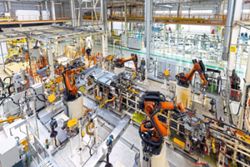
Marian Fernandez, a former employee of Zara's parent company, Inditex, rearranges clothes at the store window display of her fashion shop Maazi in downtown A Coruna. Photo: Reuters
In Spain's A Coruna, two contrasting fashion business models collide – pitching the growing demands for the clothing industry to become more sustainable against the constant need to drive sales.
This rainy, windswept, city on the rugged Atlantic coast is the unlikely headquarters of Zara-owner Inditex – the world's biggest fast fashion retailer.
Save 30% and win Bosch appliances! More Info









































